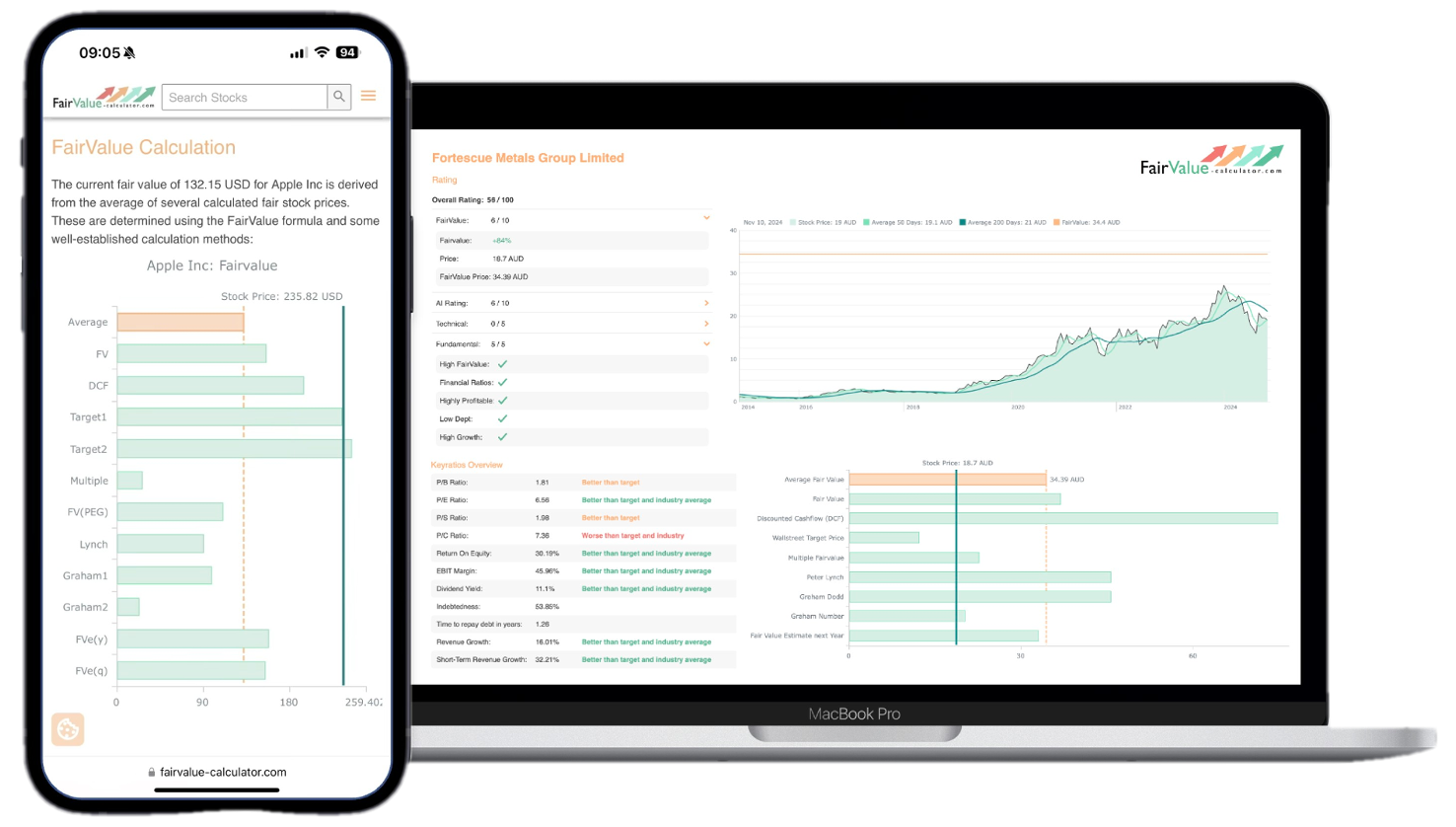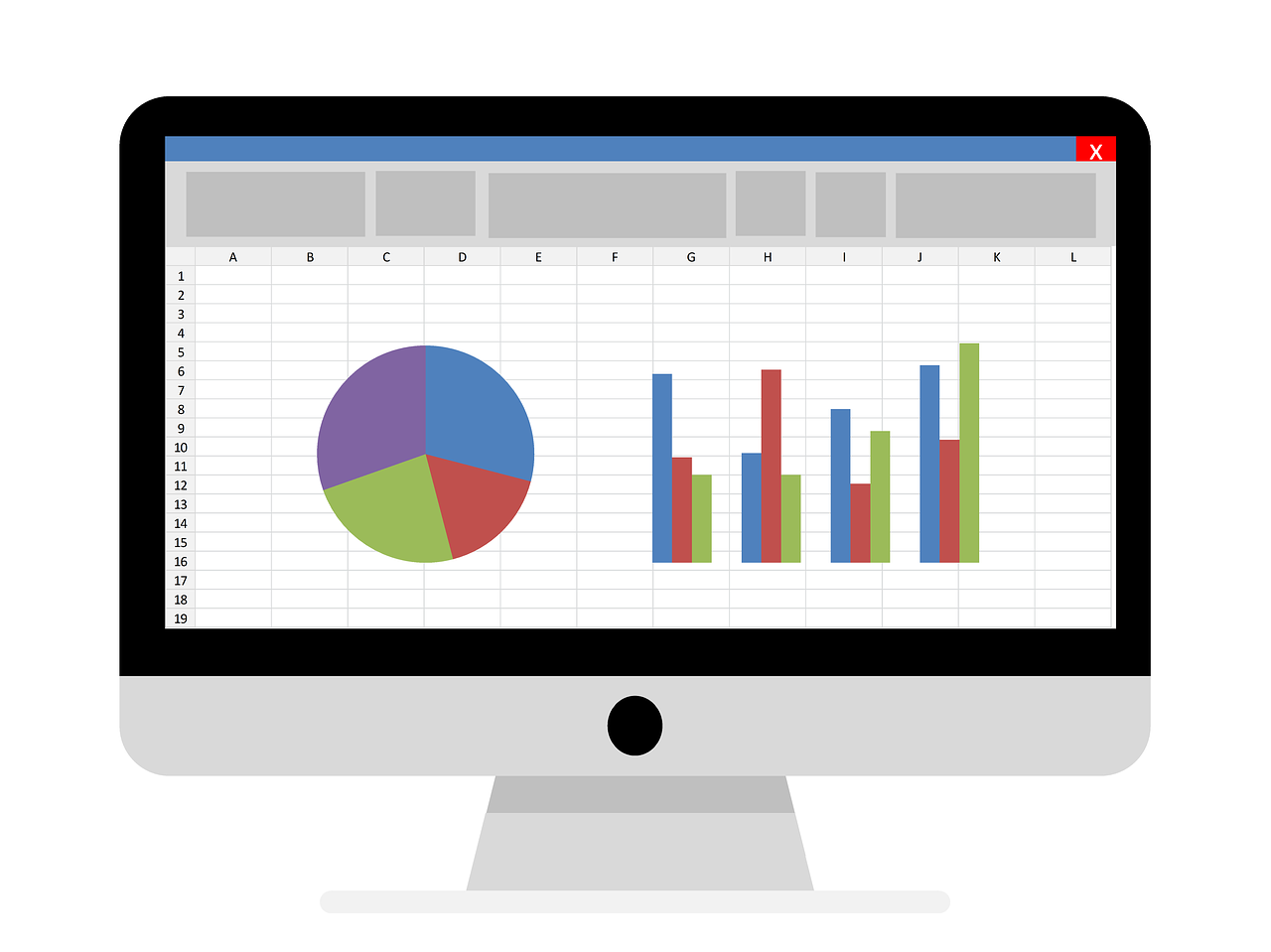In the dynamic world of investing, where every ripple sends waves through global markets, understanding the implications of a FED rate cut can be a game-changer. Imagine standing at a crossroads where decisions made by the Federal Reserve could shift the very ground beneath your investment portfolio. The current FairValue Index reading at 1.15 highlights an overvalued market, with the S&P 500 and Nasdaq 100 trading at 14% above their fair values. This paints a vivid picture: investors are navigating waters teeming with both opportunities and risks. As technology stocks continue to soar beyond expectations, sectors like Basic Materials and Energy offer a contrasting narrative of undervaluation.
💡 Discover Powerful Investing Tools
Stop guessing – start investing with confidence. Our Fair Value Stock Calculators help you uncover hidden value in stocks using time-tested methods like Discounted Cash Flow (DCF), Benjamin Graham’s valuation principles, Peter Lynch’s PEG ratio, and our own AI-powered Super Fair Value formula. Designed for clarity, speed, and precision, these tools turn complex valuation models into simple, actionable insights – even for beginners.
Learn More About the Tools →
Delving into the intricacies of a FED rate cut reveals its profound impact on stock valuations, particularly by lowering discount rates and thus inflating the present value of future earnings—a boon for growth stocks. However, the allure of these gains is not without its perils. Initial euphoria often leads to inflated prices, setting the stage for potential corrections. For savvy investors, understanding sector rotation becomes crucial, as opportunities lie in undervalued areas rather than in chasing overheated indices. Join us as we decode these market signals, equipping you with strategic insights to navigate this complex financial landscape confidently.
🚀 Test the Fair Value Calculator Now!
Find out in seconds whether your stock is truly undervalued or overpriced – based on fundamentals and future growth.
Try it for Free →Whats the reason behind the Feds decision to have interest rate cuts on hold until inflation improves?
The Federal Reserve’s decision to maintain the current level of interest rates—despite mounting calls for a FED Rate Cut—stems primarily from persistent inflationary pressures. While the central bank acknowledges early signs of cooling price growth, headline inflation remains elevated relative to its 2% target. Core measures, which exclude volatile food and energy components, are still running above desired levels. With consumer price index data showing month-over-month increases, Fed Chair Powell and his colleagues have emphasized the need for further evidence that inflation—and more importantly, inflation expectations—are sustainably declining before loosening monetary policy.
Moreover, the Fed is wary of igniting asset bubbles by acting prematurely. Financial markets have already interpreted the prospect of a future rate cut, with the S&P 500 trading at 6,467 versus a fair value of 5,647 (+14% overvalued) and the Nasdaq 100 at 23,849 against a fair value of 20,825 (+14% overvalued). Against this backdrop, holding rates steady aims to balance price stability with economic growth. By pausing rate cuts, the Fed ensures it retains ammunition for later, more decisive action, should inflation prove more entrenched than anticipated.
Explore our most popular stock fair value calculators to find opportunities where the market price is lower than the true value.
- Peter Lynch Fair Value – Combines growth with valuation using the PEG ratio. A favorite among growth investors.
- Buffett Intrinsic Value Calculator – Based on Warren Buffett’s long-term DCF approach to determine business value.
- Buffett Fair Value Model – Simplified version of his logic with margin of safety baked in.
- Graham & Dodd Fair Value – Uses conservative earnings-based valuation from classic value investing theory.
- Intrinsic vs. Extrinsic Value – Learn the core difference between what a company’s really worth and what others pay.
- Intrinsic Value Calculator – A general tool to estimate the true value of a stock, based on earnings potential.
- Fama-French Model – For advanced users: Quantifies expected return using size, value and market risk.
- Discount Rate Calculator – Helps estimate the proper rate to use in any DCF-based valuation model.
Can you explain the differences between a Fed rate cut and an easing?
In discussions of monetary policy, “FED Rate Cut” and “easing” often surface together, but they carry distinct meanings. A Fed rate cut specifically refers to a reduction in the federal funds rate—the overnight lending rate between banks. This targeted move lowers borrowing costs immediately, signaling a more accommodative stance. Easing, by contrast, covers a broader toolkit: it can include rate cuts, but also quantitative easing (QE), forward guidance, or adjustments to reserve requirements. Thus, an easing cycle may incorporate several rate cuts alongside asset purchases to inject liquidity.
While a FED Rate Cut directly influences short-term interest rates, broader easing can alter market expectations and long-term yields. Rate cuts typically transmit through bank lending, consumer loans, and mortgage rates. QE, on the other hand, affects the entire yield curve by purchasing Treasury and agency securities, pushing down yields further out. Both tools aim to stimulate spending and investment when inflation is low and growth is sluggish. Understanding these nuances helps investors anticipate policy moves and position portfolios—rotating into overvalued stocks when yields fall or targeting undervalued sectors that benefit most from improved liquidity.

The Fed has cut rates by a quarter point in November 2024 What does that mean for our money?
When the Fed trims its policy rate by twenty-five basis points, every corner of the economy feels the ripple. Borrowing costs for consumers drop: mortgages become slightly more affordable, auto loans and credit card rates tick down. Consumers may feel a subtle lift in disposable income, encouraging spending and providing a modest boost to GDP. Banks, however, see a compression of their net interest margins, which can curb lending capacity over time.
For investors, the direct effect manifests in bond and equity markets. A lower interest rate environment makes fixed income less attractive, pushing investors toward stocks, especially growth names whose valuations hinge on the present value of future earnings. With discount rates reduced, companies projected to deliver strong cash flows years ahead look more enticing, often fueling upward momentum in technology and other growth sectors. Yet, in markets already trading 14% above fair value, caution is warranted.
Moreover, money market yields and savings account rates decline, so conservative investors face reinvestment challenges. This dynamic can nudge portfolios out of cash and into risk assets, potentially inflating overvalued stocks further. Understanding these trade-offs helps individuals gauge how a quarter-point change trickles into personal finances, whether through cheaper loans, a slight bump in portfolio returns, or thinner yields on safe assets.
Why should Fed Chair Powell cut interest rates?
Advocates for a FED Rate Cut argue that lower interest rates would stimulate borrowing, investment, and consumption, thereby bolstering economic growth. In an environment where GDP growth has decelerated, businesses may be reluctant to expand without cheaper financing. A rate cut could revive capital expenditure, hiring, and consumer spending—key drivers of a healthy economy. With labor markets showing signs of cooling, a gentle nudge from lower interest rates could prevent a downturn in employment.
Another argument centers on the global arena. Other major central banks have already eased, and keeping U.S. rates elevated risks dollar strength, which makes American exports less competitive and exacerbates global financial stress. A rate cut would help rebalance exchange rates, supporting U.S. multinational profitability and easing pressure on emerging markets.\p>
Finally, subdued inflation forecasts—tempered by moderating supply chain disruptions—provide room for a cut without jeopardizing price stability. Proponents highlight that a calibrated interest-rate reduction now could preempt a sharper economic slowdown later, underlining the Fed’s dual mandate of maximum employment and stable prices.
Are traders correct in betting the Federal Reserve will cut rates at least four times this year?
Market-implied probabilities, drawn from fed funds futures, currently price in multiple cuts, reflecting optimism for future FED Rate Cuts. Traders anticipate that the Fed will deliver four quarter-point reductions over the next twelve months, translating to a cumulative one-percentage-point easing. This betting underscores a belief that inflation will cool meaningfully and that economic data will warrant proactive support.
However, historical precedent counsels caution. The Fed has often signaled rate cuts far in advance, only to moderate its pace when data disappoint. Additionally, geopolitical shocks or renewed inflationary pressures—perhaps from energy markets or labor costs—could delay or diminish the expected easing cycle. Investors should weigh these futures-based forecasts against real-time economic indicators, such as the core personal consumption expenditures index or weekly jobless claims. While traders may be correctly anticipating eventual cuts, the timing and magnitude remain subject to evolving macroeconomic conditions and Fed communication.
How has Wall Street reacted to the Federal Reserves third cut to interest rates in 2024?
News of the Fed’s third interest rate cut in 2024 sparked an immediate rally across equity markets, with the S&P 500 climbing over 1.2% on the announcement day. The Nasdaq 100 outperformed, rising nearly 1.8%, as growth stocks benefited most from lower discount rates. Momentum-driven sectors—software, internet retail, and biotech—saw outsized gains, reflecting investors’ eagerness to chase higher valuations with cheaper borrowing costs in place.
Nonetheless, beneath this initial euphoria lies a note of caution. Trading volumes moderated after the first surge, and several large-cap value stocks, particularly in Banking and Industrials, lagged behind, suggesting selective positioning rather than a wholesale rush into equities. Credit spreads tightened slightly, indicating improved risk appetite, but bond yields on the 10-year Treasury remain near 4.2%, implying some skepticism about the sustainability of aggressive expansions. Overall, Wall Street’s reaction has been optimistic but measured, with traders keenly monitoring upcoming inflation data for confirmation that the easing cycle is justified.
Will the market rally if the Fed cuts interest rates when the economy remains strong?
History shows that market rallies often accompany rate cuts, provided underlying economic fundamentals are solid. In 1995 and 1998, rate cuts during expansionary periods fueled new bull markets, as cheaper financing amplified corporate earnings growth. When consumer demand remains healthy and corporate balance sheets are robust, a FED Rate Cut acts as a stimulant rather than a rescue measure.
Yet, in today’s context, where the FairValue Index stands at 1.15 and key indices trade 14% above fair value—the potential for a rally may be muted by valuation headwinds. Overvalued stocks, particularly in Technology (notably Software and Electronic Components), may struggle to sustain momentum if they are already priced for perfection. Instead, investors might see rotation into more affordably priced areas. Ultimately, a rate cut against a backdrop of strength could trigger a rally, but its breadth and longevity will depend on corporate profitability and whether investors view valuations as justified after the initial burst of liquidity-driven enthusiasm.
What does the pause in rate cuts by the Federal Reserve mean for the US economy?
A pause in the easing cycle signals the Fed’s commitment to price stability. By halting further cuts until inflation shows clear signs of deceleration, the central bank aims to avoid rekindling broad-based inflationary pressures. For businesses and consumers, this translates into a stable, but not falling, interest rate environment, reducing uncertainty around borrowing costs and planning horizons.
From an investment standpoint, the pause leaves bond yields relatively lofty, supporting savers but dampening demand for risk assets. Equity markets may consolidate, with volatility spikes as investors reassess valuations. On the real economy front, companies with high leverage feel the pinch of sustained financing costs, potentially delaying expansion plans. Conversely, sectors less sensitive to rates, like Basic Materials and Energy, currently undervalued, may attract attention as defensive plays. In sum, the pause balances growth support with caution against overheating, anchoring expectations for a gradual return to neutral monetary policy.
What does it mean to cut interest rate?
Cutting the interest rate refers to the Federal Reserve lowering its target for the federal funds rate—the benchmark rate that influences all other short-term borrowing costs. When the Fed cuts this rate, banks can borrow from each other more cheaply, which typically leads them to offer lower lending rates to businesses and consumers. Mortgages, auto loans, and corporate debt generally become more affordable, stimulating economic activity.
In practice, the Fed instructs the trading desk at the New York Fed to purchase securities from primary dealers, adding reserves to the banking system and pushing the federal funds rate down toward the new target. The move signals an easing bias, reshaping expectations for future monetary policy and influencing long-term interest rates through market psychology. By cutting rates, the central bank seeks to encourage borrowing, investment, and consumption to sustain economic growth and employment.
Understanding the Federal Reserve Rate Cut
A FED Rate Cut lowers the overnight federal funds rate, directly influencing borrowing costs and signaling a dovish monetary stance. It serves as the primary tool for providing monetary stimulus when inflation is in check but economic growth is slowing. Investors watch Fed statements closely, interpreting rate cuts as a cue to adjust portfolios toward higher‐beta assets.
With the FairValue Index at 1.15, markets may already price in anticipated cuts, so the timing and magnitude of future moves become critical. Understanding the mechanics helps investors anticipate policy shifts and manage position sizing, particularly in interest‐rate‐sensitive sectors.
Impact on Stock Valuations: Lowering Discount Rates
Lower interest rates reduce the discount rate used in valuation models, boosting the present value of future cash flows. Growth stocks, whose earnings are projected years ahead, benefit most from this recalibration. A 25-basis-point cut can raise valuations by several percentage points, justifying premium multiples during easing cycles.
However, when broad indices trade 14% above fair value, additional multiple expansion carries risk. Investors must weigh higher valuations against fundamentals, differentiating between companies with sustainable growth and those priced purely on liquidity-driven optimism.
Present Value of Future Earnings: Growth Stocks Perspective
Growth companies, particularly in Technology, rely heavily on discounted cash flow (DCF) valuations. A FED Rate Cut lowers the discount rate, inflating the present value of earnings expected years into the future. This dynamic can drive share prices higher, especially for Software and Electronic Components, currently the most overvalued subsectors.
Yet, when valuations exceed fair value by double-digits, the upside becomes constrained. Investors should identify names with high revenue visibility and strong free cash flow generation to minimize downside if the initial euphoria fades, and discount rates remain at historically low levels.
Potential Market Corrections: Managing Euphoria
Initial rallies following a rate cut often lead to overpricing, setting the stage for subsequent pullbacks. In past cycles, markets have retraced 5–10% within months after the first surge, as profit-taking and valuation concerns emerged. Managing this euphoria requires discipline—locking in gains in richly valued stocks and reallocating to sectors with more reasonable multiples.
Tools like stop-loss orders and systematic rebalancing help contain downside. Recognizing that overvalued stocks may correct sharply once the liquidity impulse fades is crucial for preserving capital and staying invested through the full cycle.
Sector Rotation Strategy for Savvy Investors
Rather than chasing broad indices at lofty valuations, investors can rotate into undervalued or fairly priced sectors. With interest rates falling, cyclical areas like Consumer Discretionary and Industrials can benefit from revived spending, but only when valuations align. Meanwhile, bonds become less attractive, nudging allocations toward equity segments offering yield, such as Utilities and Real Estate Investment Trusts (REITs).
Timing the rotation requires monitoring the Fair Value Calculator, sector heatmaps, and macro data. By shifting capital away from overbought Tech names toward undervalued segments, investors capture upside with lower risk of abrupt corrections.
Opportunities in Undervalued Sectors
Heatmap analysis reveals compelling opportunities in Basic Materials and Energy, sectors trading below fair value. Solar and Electronics Distribution within Technology also show pockets of value, despite broad sector overvaluation. Commodity-linked stocks benefit from improving demand expectations, while Energy names trade at historically depressed valuations relative to cash flows.
Auto Parts and Specialty Retail, though expensive in Consumer Cyclical, contrast with undervalued peers in Industrials and Materials. Allocating to these undervalued segments can enhance returns while moderating portfolio volatility during market swings triggered by a FED Rate Cut.
Cautions Against Chasing Overheated Indices
With the S&P 500 and Nasdaq 100 each 14% above fair value, broad market exposure carries heightened risk. Overvalued stocks often underperform in subsequent quarters after initial rallies, especially if fundamentals fail to catch up. Chasing indices at peak levels can lead to buying near tops and suffering larger drawdowns.
Instead, investors should focus on selective deployments—targeting mid-cap and small-cap names with strong balance sheets and earnings resilience. Reducing exposure to richly valued leaders in favor of undervalued or fairly priced alternatives helps mitigate downside risk when the liquidity wave recedes.
Strategic Insights for Navigating the Financial Landscape
A FED Rate Cut presents both opportunities and pitfalls. By understanding how lower discount rates lift valuations, investors can identify which sectors and stocks stand to gain most. Equally important is recognizing the danger of overpricing and preparing for corrections. A disciplined approach—grounded in data from the Fair Value Calculator, sector heatmaps, and macro indicators—enables strategic allocations.
Maintaining a diversified portfolio, rotating into undervalued sectors, and employing risk management tools will help navigate the shifting tides of monetary policy. With clear insights and an adaptable strategy, investors can capitalize on rate cuts without succumbing to market euphoria.
Conclusion: Deciphering the Market Signals
Navigating the implications of a FED Rate Cut on stock valuations demands rigorous analysis and disciplined execution. By integrating the Fair Value Calculator’s insights into your investment process, you can monitor not only individual securities but also sector and industry dynamics in real time.
Whether rotating into undervalued sectors like Basic Materials or tempering exposure to overheated indices, a data-driven framework offers clarity amid uncertainty. Armed with these strategic insights, investors can confidently decode market signals and position portfolios for both growth and resilience.








vitstarz
I just like the helpful information you provide in your articles
Theresa
Awesome! Its genuinely remarkable post, I have got much clear idea regarding from this post
Kayden
The guide is very complete, suitable for both beginners and experts.